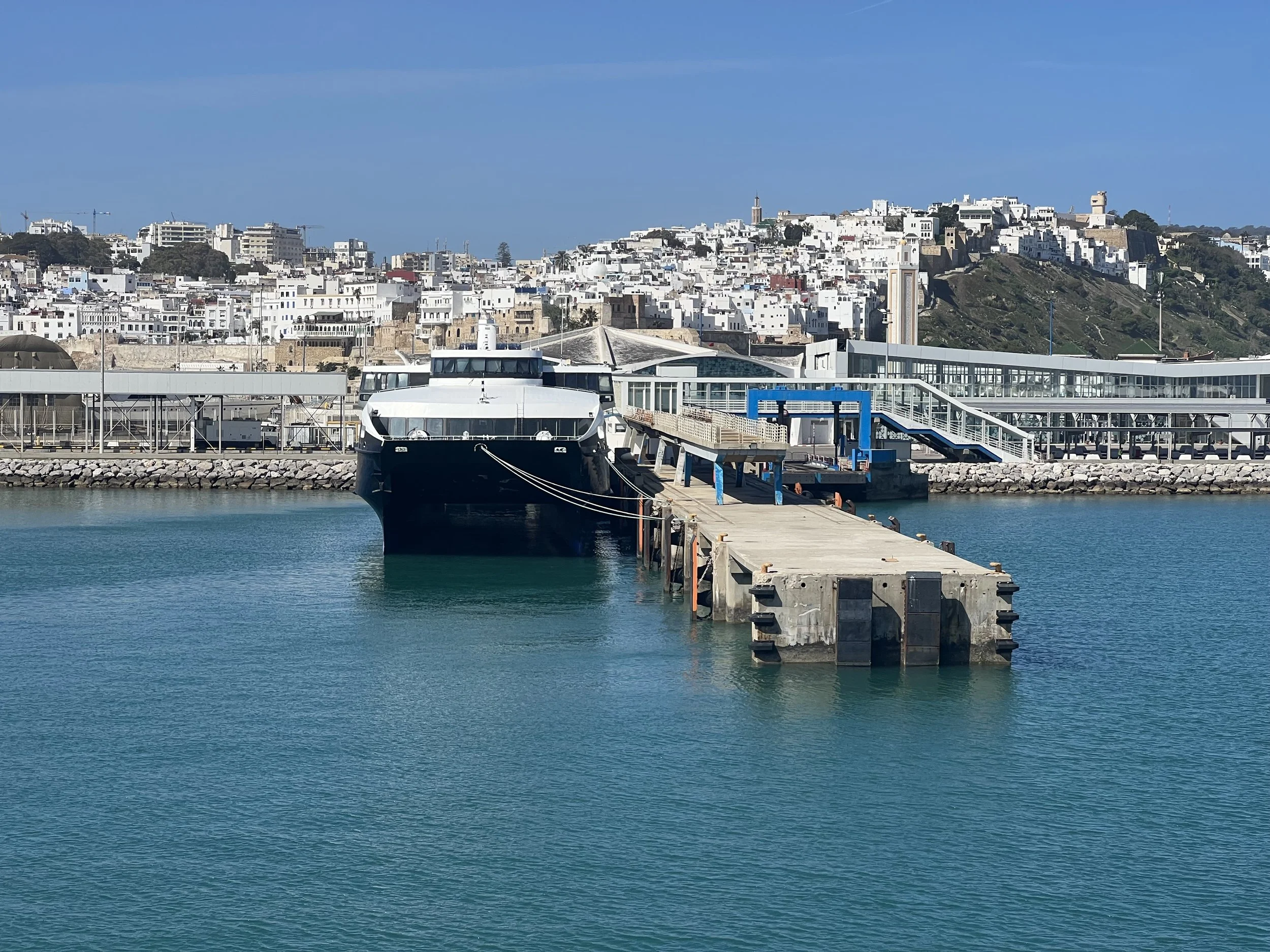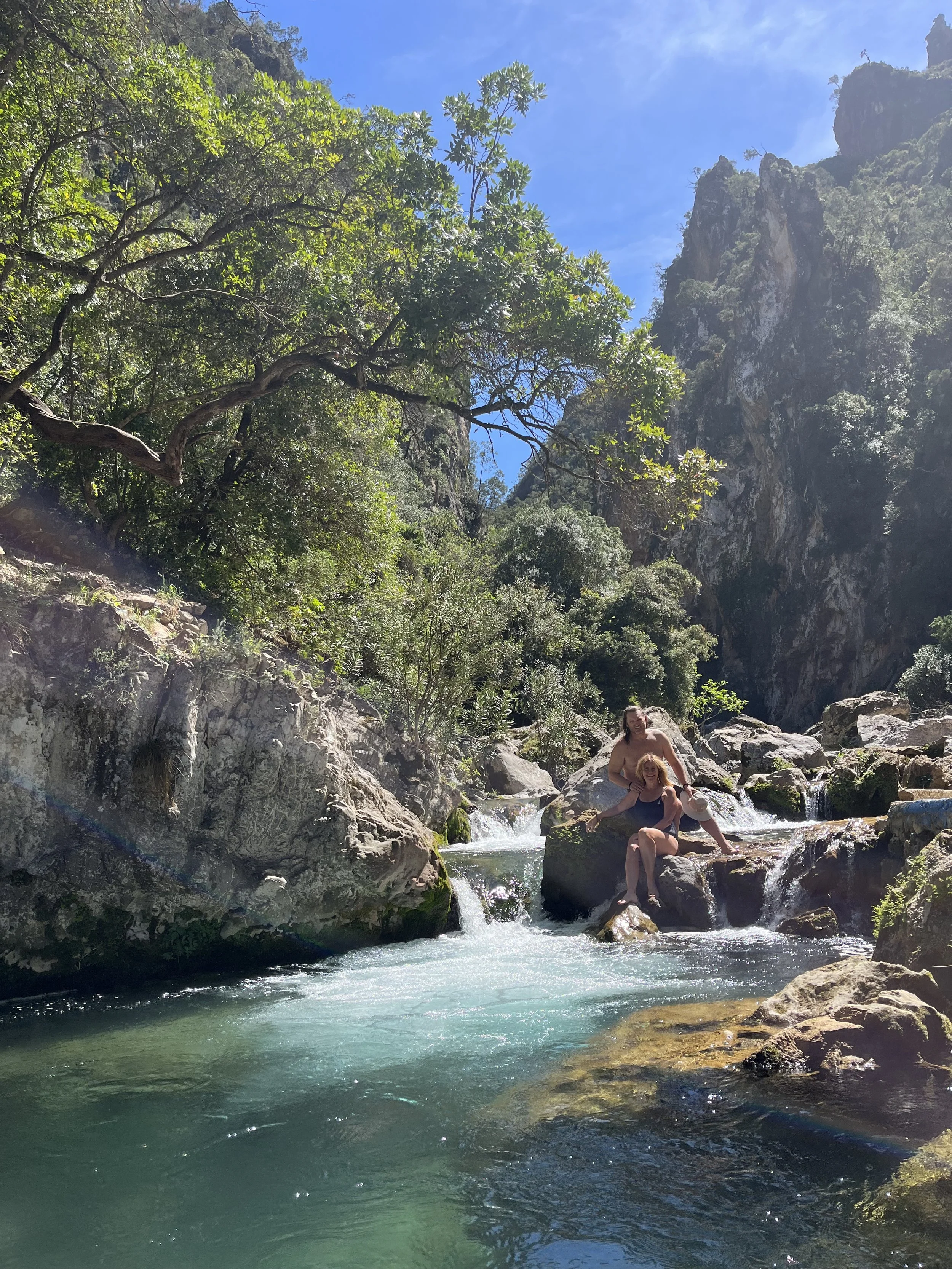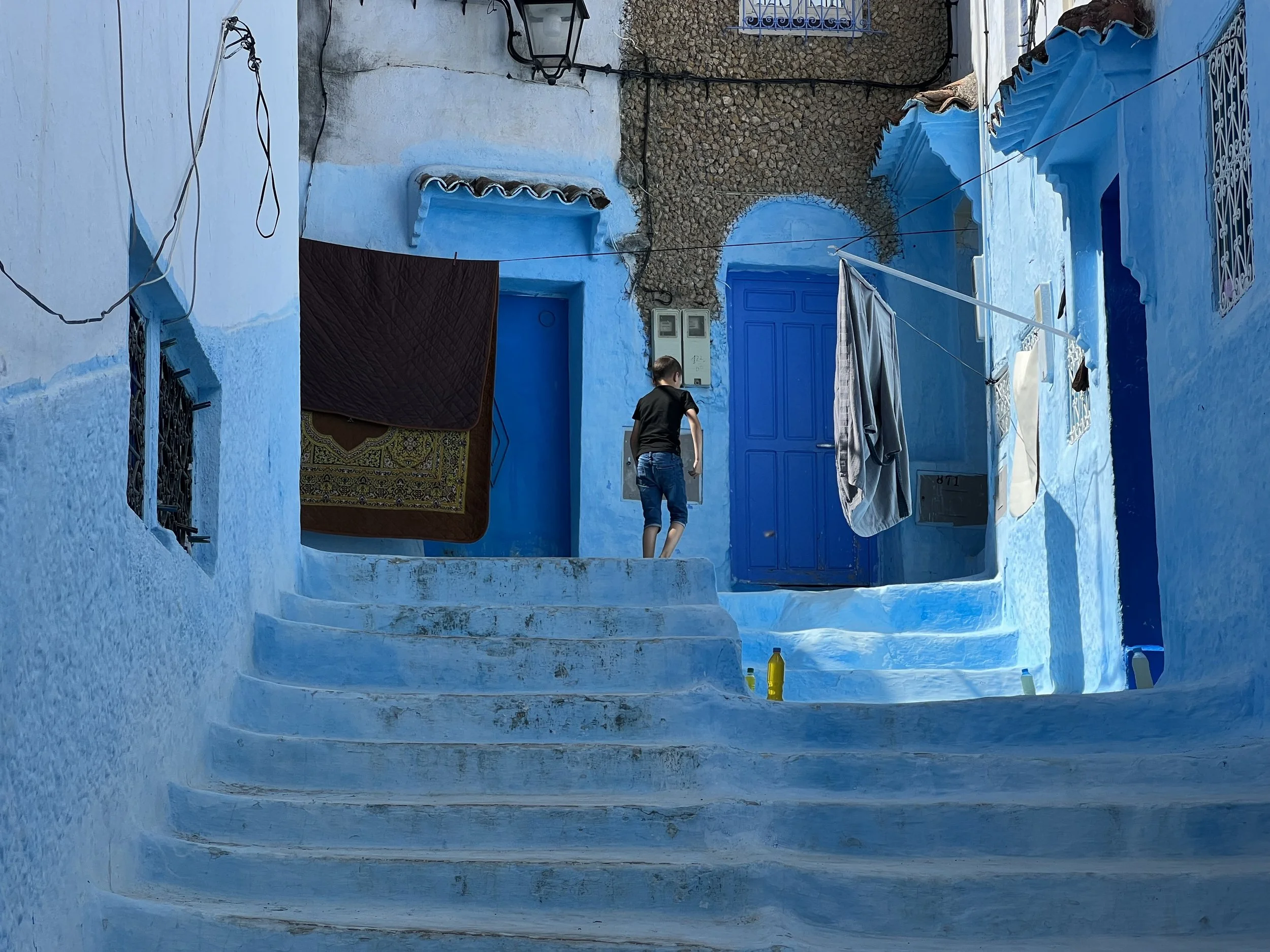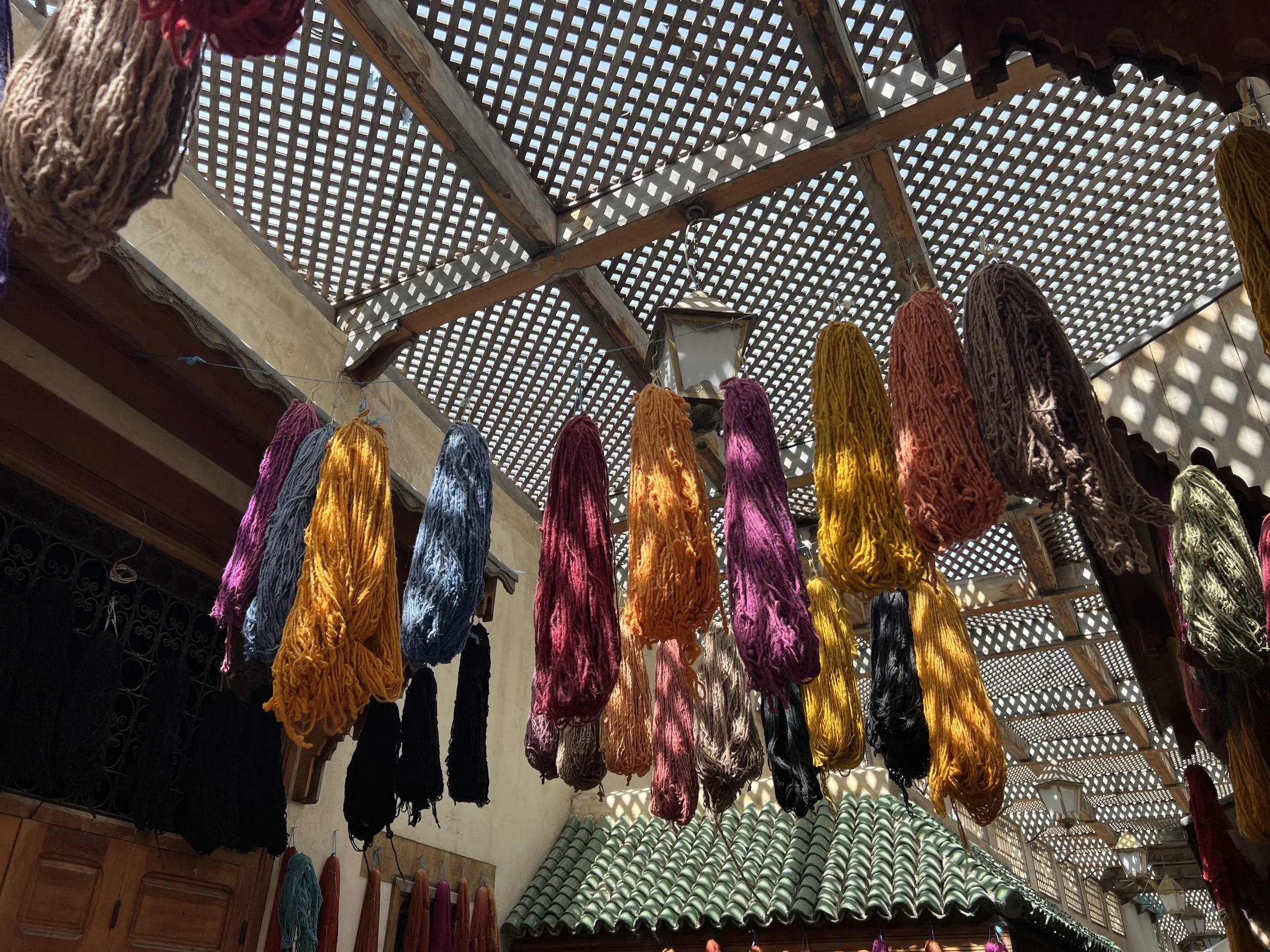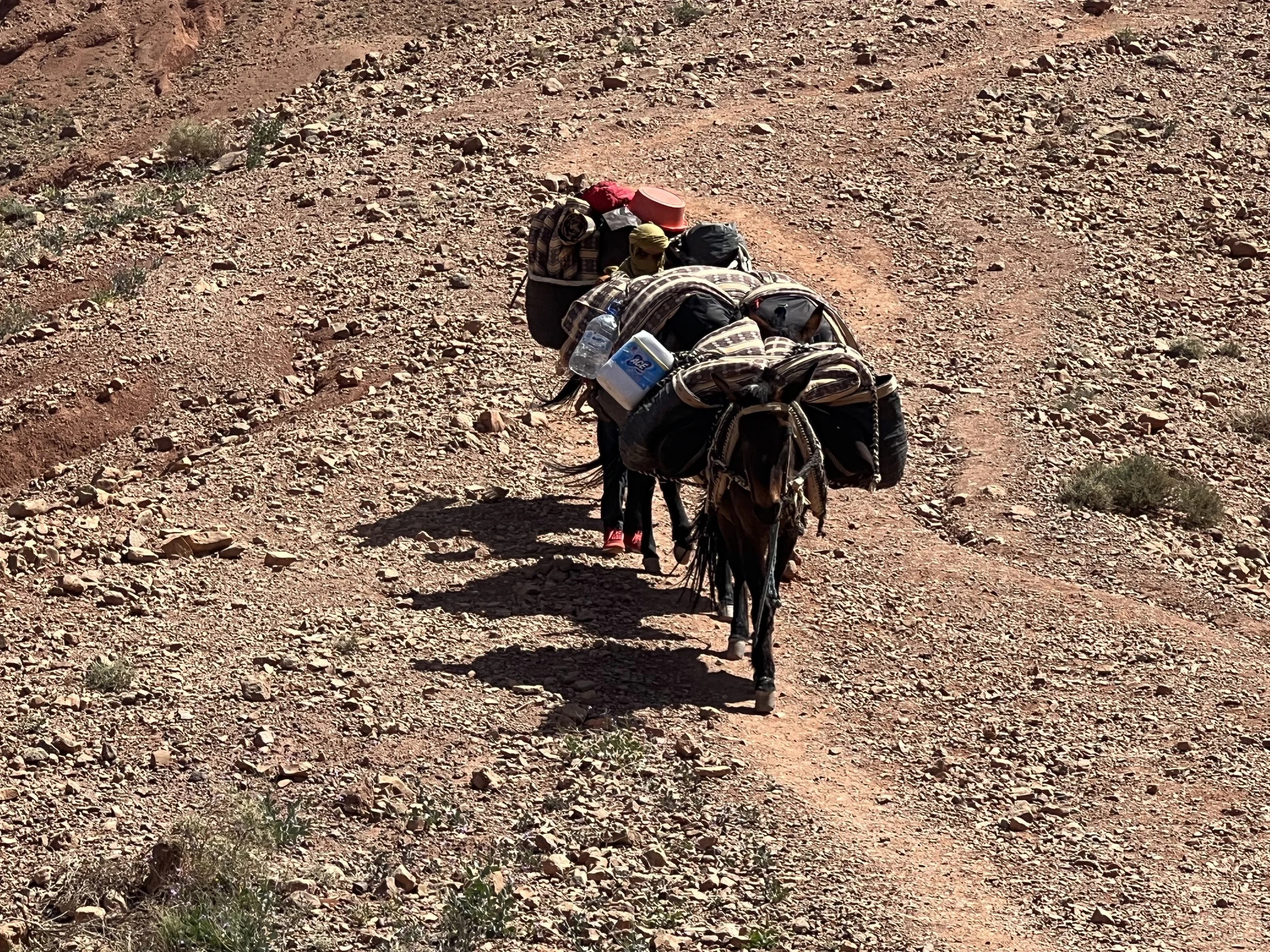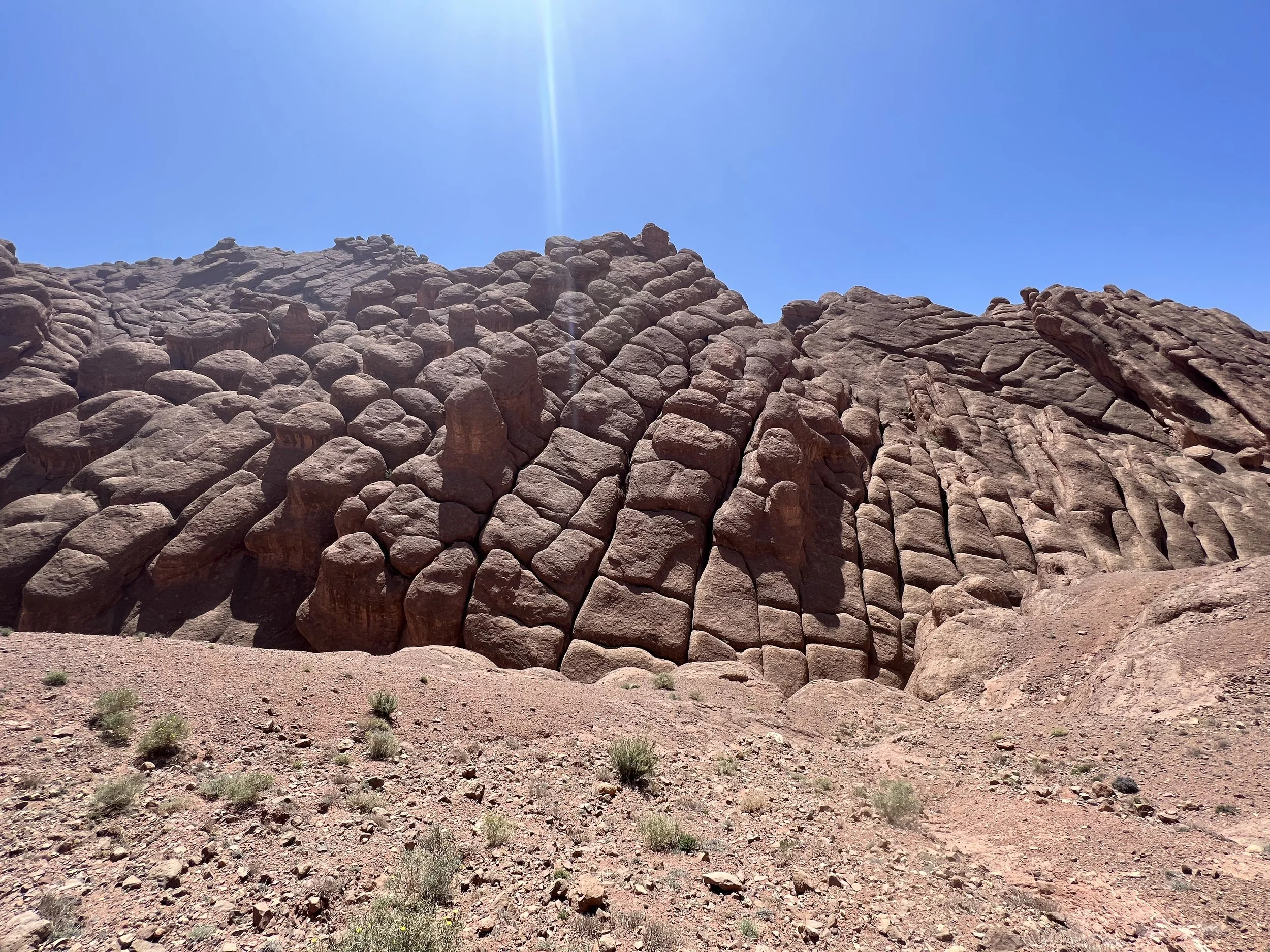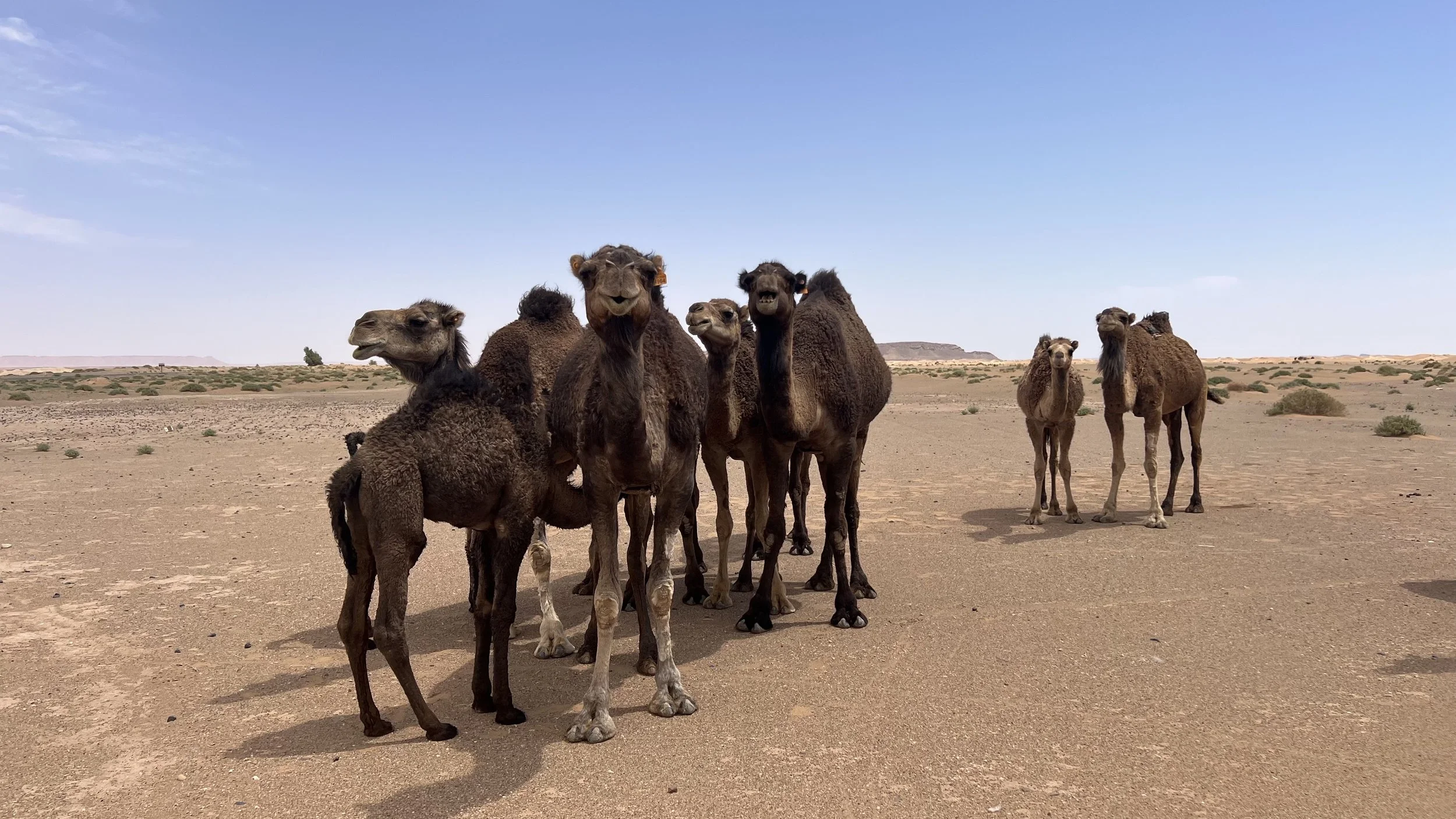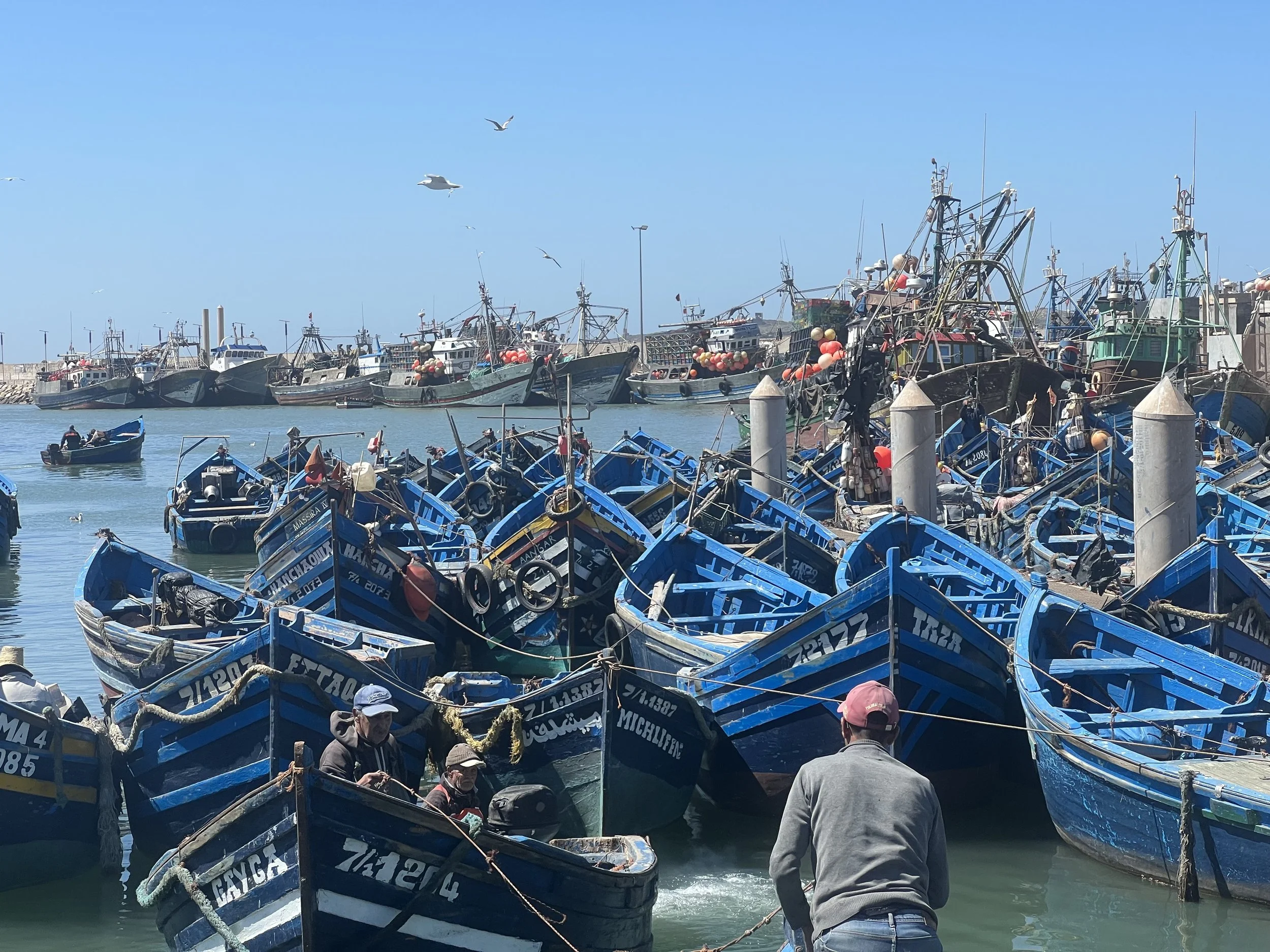Morocco - 17 Day Itinerary
As we were in Morocco for a whirlwind adventure, I thought I’d publish our itinerary including the places we visited and any travel tips that might be useful for your future travels. I usually read a lot of blogs, watch Youtube videos and use Google Maps to plan our trips, but the reality is plans change on a whim depending on our moods, physical state, what’s going on in the area, and any suggestions given to us from locals. The point is our travel plans are flexible and Morocco sure reminded us how important it is to adapt to changes as both of us fell ill at different points throughout our trip making it necessary to rethink and change course. Keep that in mind when planning your future trips!
Day 1-4 - Tarifa Spain to Chefchaouen Morocco
Departure
There are many ways to get to Morocco depending on your place of departure. We took a ferry from Tarifa, Spain to Tangier, Morocco. We booked through Ferry Hopper which was very simple. Their website is very detailed and can answer all your questions. It’s amazing how close Morocco is from Tarifa - approximately 30 km - therefore making it a short ferry ride across the Strait of Gibraltar. Once on board, you’ll get your passports stamped at Passport Control making it convenient to disembark.
Tip: Arrive 15-20 minutes early at the Tarifa Ferry Terminal; no need to be waiting any longer. Also, keep in mind that all departures are weather dependent. The high winds in the area often delay the crossings (as we found out upon our return) - sometimes for days!
Upon arriving at Tangier Ville, we quickly took a taxi (readily available) to the Bus Terminal to catch our bus to Chefchaouen. We booked our online bus ticket previously through CTM Bus Company.
Tip: Allow about 10 minutes to get from the Tangier Port to the Bus Terminal. Also, the CTM website states you have to print out your bus tickets but it’s not necessary. You can show the e-ticket on your phone.
Port de Tanger Ville
Arrival in Chefchaouen
We took a taxi from the bus terminal in Chefchaouen to our Riad that was located in the Medina. It only costs a few Euro.
Tip #1: Different size taxis (petite and grand) are waiting outside the Bus Station in Chefchaouen. We got dropped off at the Medina gate where the owner of the Riad met us. This was crucial as we would never have found the Riad in the Old Medina.
Tip #2: We got the name and number of our Taxi Driver so we could use him for the remainder of our stay. You can email us for his number if you go to Chefchaouen.
Things to Do in Chefchaouen!
I was sick for most of the trip, but we managed to do a few amazing things:
Suggestion #1: Our taxi driver took us through the Rif Mountains to visit Akchour and hike the God’s Bridge. We hiked the trail to God’s Bridge and then swam in the river below it. You can also hike a second trail that leads to a small and large waterfall.
Tip #1: We used the same taxi driver throughout our trip and highly recommend you do the same. The drive through the mountains was absolutely stunning. You’ll see a lot of vegetation, including legal cannibas farms, and local villages. We arranged for our taxi driver to pick us up at the end of the day. Akchour is a 45 minute drive from Chefchauen.
Tip #2: Bring your swimsuit. After the moderate hike to the top of the Arch, we delighted in a refreshing swim; we channelled our Wim Hof!
Tip #3: Bring some cash as there are plenty of options along the walk to eat some local Tangine and get a drink. There are readily available washrooms too.
Tip #4: You may want to read a more detailed blog about how to access the walk up to the waterfalls and God’s Bridge. There are no signs causing a bit of confusion.
A little swim after hiking God’s Bridge
Suggestion #2: Walk the narrow alleyways of Chefchaouen or Chaouen. Only then will you truly appreciate the “Blue City”. Most of the buildings are painted some shade of blue. Why blue? Some say it’s to help regulate the building’s temperature, others say it helps ward off mosquitoes and finally some say the colour blue represents the sky, reminding the local Jews of Heaven and God. It is by walking the alleyways that you get a true sense of how truly authentic the people are taking pride in their culture, art, agriculture and religion.
Suggestion #3: Visit a local Hammam - not a fancy one - a local one. I went to Hamam Meslouhi to get the scrubbing of a lifetime. I’ve never experienced such bliss. The attendant didn’t speak English and I don’t speak much French but we both managed. Bring your own towel and bathing suit bottom. I didn’t have either so she gave me a towel and I went in my underwear.
Further suggestions: As I was sick for half of our trip, we didn’t manage to get to the Spanish Mosque, a lookout high above the town. It would have been a great spot to catch the sunset.
Chefchaouen
Day 4 - Day 6 - Chefchaouen to Fez
Departure
We woke up early to catch our taxi (same driver - see the pattern) back to the Bus Station. Again, we booked our bus tickets early as is our habit but some people do purchase them at the station; that’s too risky for us. So it takes a little over 4 hours to get to Fez from Chefchaouen. We decided to stay in a Riad just outside the Medina and our taxi driver not only dropped us off as close to the Riad as possible, but made sure we knew how to get there; it was basically around the corner.
Things to Do in Fez!
Walk the Medina and tour the newer part of the city. Fez is the second largest city in Morocco with a population just over a million. During the 8th-9th centuries, Fez consisted of two settlements of mostly Arab immigrants and it wasn’t until the 11th century the two were merged as one under the Almoravid rule. It was during this time the city flourished and became known for its religious and commercial interest, peaking in the 15th century establishing madrasas, mosques and royal administrative buildings demonstrating the now famous Morocco architecture. It was also during this time the Jewish Quarter or Mellah was formed on the south side of the city under the rule of King Idris II who encouraged openness and acceptance among the people of different faiths.
Today, the city is a World Heritage Site and consists of two medina; namely Fes El-Bali and Des Jdid and the newer Villa Nouville. The old Medina boasts being the world’s largest pedestrian zone, is home to University of Al-Qarawiyyin, the world’s oldest, and contains the famous tannery, the Chourara.
Tip #1: Without a doubt, you need to hire a guide to tour Fez. Fez has the largest Medina in the world and you don’t want to get lost - and you will if attempting it on your own. Not only will your guide do just that - guide you - if you’re lucky - you’ll learn a thing or two about the historical and cultural importance of Fez. We hired our guide through Airbnb Experiences but you can book through a variety of tour groups including Get Your Guide (we like them); just make sure your Guide is a local licensed guide.
Tip #2: Carry cash (Dirham or MAD). You’ll find most shops and restaurants in the Medina only accept MAD. We found ourselves in a predicament when we couldn’t get money out of the ATMs located around the Medina. Turns out the instructions didn’t translate correctly, but we eventually got the cash out the next day. Regardless, we do travel with a couple of Debit cards from different banking institutions in Canada and a few credit cards. We have both Canadian and American Visa cards along with an American Express. We prefer to use the AE as we collect Hilton points but unfortunately it isn’t widely accepted. It also gives us the lowest foreign transaction fees.
Further Suggestions: Although we didn’t, you can take a couple more days to explore the surrounding areas including Meknes, Volubilis, Moulay Idriss and Ifrane National park located in the Middle Atlas Mountains.
Fez
Day 6 - 9 - Fez to Marrakech
Departure
Upon the advice of a fellow Canadian traveller, we took the train from Fez to Marrakech. After breakfast, we walked about 500 m from our Riad to the roundabout to hail a taxi. It was pretty seamless. The train cost under €100 and took about 6.5 hours.
Arrival in Marrakech
This is when things get interesting. The train arrives at the Rail Terminus, a beautiful station built in 2008 and adorned with a tiled facade and marble interior. Once you depart the station, there will be a sea of private drivers and taxis. The taxi drivers will come for you so do your research in advance and know the approximate cost of the ride to your accommodation; ask your hotel or Riad reception.
Tip #1: We usually consult with Rome2Rio for all our transportation planning. We find it pretty accurate and simple to use. It will give you a variety of ways to get from Point A to B.
Tip #2: Listen up! If you are staying in the Medina, the taxi will let you out at the roundabout, if you can call it that, where many men are waiting with baited breath to “help” you with your luggage. It can be very chaotic and they will aggressively man-handle your luggage into their cart whilst asking the name of your Riad or hotel; all this before you get out of the taxi. You need to keep a level head and negotiate a price (again -ask the reception at your hotel or Riad). If the price isn’t set before you begin your journey, you’ll hear the nice man say something like this - “As you will” - leaving it up to you to decide how much he will receive once you and your luggage are safely at your accommodation. Unfortunately, arguments usually ensue on the nice man’s part as he wants more money and this can be intimidating. The whole scene is scandalous and sometimes even violent as we, and other tourists we met, witnessed physical fights amongst these guys. So, now you’re warned. But don’t let this deter you from going to Marrakech. You just have to be savvy.
Things to Do in Marrakech!
Marrakech is the fourth largest city in Morocco and is referred to as the “Red City” referring to the colour of the walls and structures build by the Almoravids around 1122. After a period of decline and then rise again under the Saddian Sultans, Marrakech re-established itself as a major cultural, religious and trading centre. Gaining independence in 1956, it became a hot spot among the “hippies” and “enlightened” of the entertainment world.
The Old Medina, including Jemma el-Fnaa, is a UNESCO World Heritage Site. Today, it has the largest market in Morocco and is home to 18 souks in total. The souks were traditionally divided into retail areas specializing in pottery, leather, carpet, metal and food.
Suggestions: So after much research, we narrowed our focus to the following: Ben Yousuf Madrassa, Le Jardin Secret, Bahá’í Palace, Jemma el-Fna, Koutoubia, Badi Palace, Ban Agnaou and the Saadian Tombs.
Further Suggestions: If we had more time, I’d visit a few of the museums around the city, Jardin Majorelle-Yves Saint Laurent Mansion, the Mellah and the Menara Gardens.
Tip #1: You’ll get tired of Marrakech before you get through your list. Marrakech is overwhelming and an overload on your senses. By the end of the third or fourth day, you will begin to feel tired of sightseeing and experience the “ABC” syndrome or what my father-in-law refers to as “Another Bloody Castle/Church”. In our case, we just switched out the last consonant and filled in the blank (i.e. ABP - Another Bloody Palace). You’ll love your experience, but not regret leaving a few days in.
Tip #2: We mostly use Booking.com to book our accommodations and you’ll find most hotels and Riads use it to list their properties. I first discovered this in Argentina. The advantage for us is the “loyalty discount” applies to our final prices. If you haven’t stayed in a Riad, a traditional Moroccan house, make sure you do so before leaving the country. We’d already experienced a Riad in both Chefchaouen and Fez and we booked another in the Marrakech Medina. In hindsight, I wish we had stayed outside of the Medina. Medinas can be quiet loud and face paced. I highly recommend booking your accommodations on the outskirts and making your way through the chaos of the Medina on your own terms.
Classic Marrakech
Day 9 - 12 - Marrakech to the Dades Gorge
Departure
We were not looking forward to catching a taxi at the aforementioned roundabout, but it ended up being pretty painless. We rented a car for the remainder of the trip as we wanted to explore southern Morocco and the coast.
Tip #1: Get a variety of quotes, including full coverage. Brent always gets a minimum of 3 quotes and then picks the best deal. We always get full coverage as our credit cards do not cover “Third Party” insurance. This is a mistake most people assume, so we encourage you to review your policy in detail before renting a vehicle abroad. Our medical insurance is covered by another policy.
Things to Do!
We left quite early in the morning to have time to explore Ait-Ben-Haddou, a UNESCO site, located in the Quarzazate province. Ait-Ben-Haddou is an example of southern Moroccan architecture characterized by earthen dwellings, towers and a fortified wall. Recently, it has become a dream location for movie studios, hence why quite a few movies, including Game of Thrones and my fave - Gladiator - were shot there.
We only spent a couple of hours in the area before heading to our accommodation. We stayed at Kasbah Art Benhadda, a beautiful property. Unfortunately, Brent started getting sick around this time which would end up changing most of our plans for the Sahara.
Early the next morning, we headed to the Dades Gorge area where I hiked “Monkey Fingers” solo. Brent stayed in bed for another two days.
The Dades Gorge is a series of gorges carved out by the Dades River. It was formed millions of years ago when it was submerged under water. The tectonic plates eventually formed the Atlas Mountains and the river itself. Today, the surrounding area is home to many Berber villages, rose fields, olive groves, and almond and palm trees. The Monkey Fingers are rock formations that have been carved over years that resemble, you guessed it, monkey fingers.
Tip #1: There are some stunning accommodations in this area and I highly recommend that you treat yourself and stay in one. You’ll experience what it’s like to stay in an earthen dwelling, be served mint tea upon arrival and luxuriate in the gardens. Most are reasonably priced.
Tip #2: We used MAPS.ME to navigate our way through most of Morocco. It’s a mobile app that provides offline maps. We couldn’t have survived our trip without it.
Tip #3: Drive the Road of A Thousand Kasbahs or R704 which is a series of switchbacks along the Dades River. It is not for the faint of heart but who doesn’t want to challenge their driving skills. Unfortunately, we couldn’t drive it this time as Brent was still sick the day of our departure. Next time!
Tip #4: Hike the Monkey Fingers! I did a solo hike but I would suggest hiring a guide as parts of the canyon are a bit gnarly for one person and I did take a couple of wrong turns. I found these blogs to be the most useful to navigate this part of the adventure: Trip Savvy and The Unknown Enthusiast.
Berber Life
Monkey Fingers
Day 12 -13 - Dades Gorge to Merzouga
Arrival
It took about 4 hours to drive from Dades Gorge to Merzouga. I know what you’re thinking: Why did you only spend one day in Merzouga? Unfortunately Brent was still really sick and this is the point where all our desert plans went out the window or at least modified.
Things to Do in Merzouga!
We stayed at Riad Les Jardins de Merzouga for our one night stay. Brent went to bed upon arrival and I hiked up the dune located right behind our Riad to catch the sunset. It truly was magical to lay in the hot sand and heal my 55 year old aches and pains. Following my solo adventure, I talked to a young man who had a camp right outside the Riad and booked a camel ride for the morning - for Brent only. I’m still coming to terms with the ethics of camel riding.
Tip #1: Most people coming to Merzouga stay for a minimum of two nights. I would highly recommend booking an overnight “Sahara Desert Luxury Camp” to experience the Erg Chebbi. Erg Chebbi, although not technically part of the Sahara, are large dunes that most of the camps choose to run their adventures from. Upon arrival in Merzouga, you’ll take a camel or 4X4 to the dunes for an overnight “glamping” trip where you dine on Tangine and are entertained by local musicians. There are many of these camps available so read the reviews before booking.
Tip #2: Camel riding, just like elephants, is a source of contention among the animal welfare activists. Camel riding is a major tourist activity and a source of income for the locals but that being said do your own research on the welfare of the camels before booking your trip. There’s lots to learn. This article is adequate and should give you a start to your research: Camel Riding.
Cuteness!
Day 13 - Day 16 - Merzouga to the Coast (Essaouira)
We spent the remainder of our trip driving to and up the Coast. Our original plans had us spending more time on the Coast, but sickness delayed our trip and we were ready to get back to Spain to regroup and see some friends.
The ride from Merzouga to the first stop on the Coast, Sidi Fidi, is over 11 hours. We took N12 across and stayed in Tata, just over mid-way. N12 is probably one of the most scenic roads we’ve travelled - and we’ve traversed a lot of roads. The varying landscapes, nomadic shepherds and wildlife made what could have been a very long drive, a memorable experience.
From Tati, we drove to Sidi Ifni, on the southern part of the coast before heading north to our final destination of Essaouira. The drive took us to both coastal spots and small villages inland.
Suggestions: Here is a list of recommended places where we stopped along the coast:
Sidi Ifni (only need a short stop), Legzira ( a must stop to see the arch and have lunch, possibly an overnight), Agadir (popular beach destination), Taghazout (surfer’s paradise) and finally Essaouira (an overnight for sure or longer if you kiteboard)
Further Suggestions: Timlan Dunes (sand boarding)
Tip #1: We stayed at Riad Eucalyptus, just minutes outside the Essaouira. It was a serene property to end our time in Morocco and we even managed to squeeze in a massage. We highly recommend this Riad.
Tip #2: Buy your home goods (baskets and Tangines) at the stalls as you’re coming west from N1 on P2201 about 1.5 Km. The items are plentiful, varied and inexpensive. Don’t pay more than a few Euro for a Tangine anywhere in Morocco.
Essaouira
Day 16 - Day 17 - Essaouira to Tangier
As we came to the end of our trip, we drove the short couple of hours from Essaouira to Marrakech. After returning the car rental and a late lunch/early dinner, we headed to our hotel for a night’s rest before our departure back to Tangier to catch the ferry to Spain.
Little did we know that we’d be awake for the next 24 hours as Mother Nature had other plans for us.
We stayed at Hotel Safi (adequate) as it was a 5 minute walk to the train station. After breakfast, we gathered our luggage, walked to the train station and boarded the train for the 6 hour ride. We had a short connection from the Bus Station in Tangier to the Port de Tanger Ville, so we hopped into a taxi to catch the ferry. Here’s where everything went south!
The ferry was cancelled! Yup, those damn high winds that Brent along with all the other kite-boarders love, prevented the ferry from crossing over to Spain for the next few days. Apparently, this is a common occurrence in April. After confirming the cancellation, we quickly took another taxi to Tanger-Med, a 45 minute ride northeast of Tangier, where we were told a larger ferry would be crossing a couple of hours later and we were guaranteed our seats.
The drive to Tanger-Med was curvy and at times busy, but we made it in time to secure the Ferry. We were so elated but unfortunately the feeling of elation was quickly squashed because we ended up waiting for another 5 hours for the next available Ferry. Around 12 a.m., we boarded and although totally wiped out, we were so relieved to be on the water and heading to Spain.
Tip #1: If you ever find yourself in southern Spain and you see an offer to book a day trip to Tangier, reconsider. Lots of travellers book day trips just so they can say they’ve been to Africa, but then have no idea that they could be stuck for days due to the ferry cancellations. Our taxi driver told us the ferries had been cancelled 15 days the prior month and although you can see Spain from Tangier, you can’t swim it!
So here lies the end of our trip to Morocco. In total, we spent 17 days in this incredible country and I can now strike it off the bucket list. I’m actually impressed that we were able to do all that we did; no wonder why I slept for a few days after the trip.
We hope that our itinerary and tips will be helpful when planning your trip to Morocco or anywhere for that matter; many of the tips are good practices to adopt when travelling.
If you have any good tips for us or questions, don’t hesitate to email .
For more on our Morocco adventures, check out our Youtube playlist.
Cheers to big dreams!


